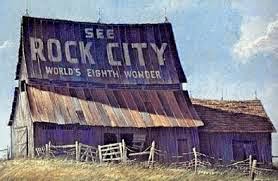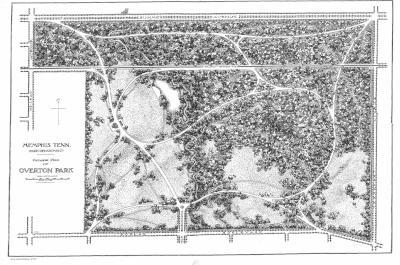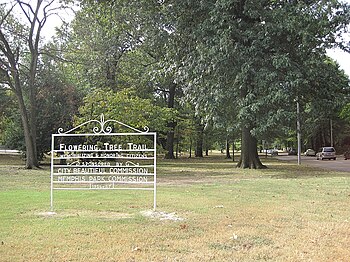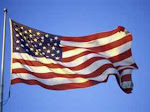Memphis entrepreneur and Catholic leader Eugene Magevney was born in
1798 in County Fermanagh, Ireland. He studied for the priesthood but
changed his mind and became a school teacher. In 1828 he immigrated to
the United States and settled in Memphis in 1833. Magevney supported
himself by teaching in a small private school, where he accepted land as
payment from cash-strapped families.
Within a few years, Magevney's land acquisitions had become large enough
to permit him to leave teaching and concentrate on real estate
development, where he made his fortune. Soon recognized as a community
leader, he served as an alderman and in 1848 led the fight to establish
public schools. Always ready to defend his fellow Irishmen, Magevney
wrote editorials in the local newspaper protesting the prejudice to
which they were subjected.
A devout Catholic, Magevney helped to establish the city's first
Catholic church and parochial school. In 1839 the first mass was
celebrated in Magevney's house on Adams Avenue, where the first marriage
(his own) and the first baptism (his daughter Mary) were also
celebrated. Magevney was also one of those responsible for the founding
of St. Peter's Catholic Church, located next to his house. In 1941 the
Magevney heirs donated the house to the City of Memphis. It is now part
of the Memphis Museum System and open to the public.
Source: tennesseeenxyxlopedia.com
Wednesday, January 31, 2018
The Memphis Parkway System
The Memphis Parkway System, locally known as the Parkway System, The Parkways, or simply by their individual names is a system of parkways that formed the original outer beltway around Memphis, Tennessee. They consist of South Parkway, East Parkway, and North Parkway. Designed by George Kessler, the Parkway System connects Martin Luther King Jr. Riverside Park with Overton Park. The system was put on the National Register of Historic Places on July 3, 1989.
In response to the yellow fever epidemic and in an attempt to
revitalize Memphis, the city's leaders decided to improve the city's
infrastructure, including improving sewer systems, creating public
utilities, and creating a system of parks connected by a system of
boulevards. Starting in 1897, several areas of land were annexed into
the city, along with the areas that now comprise the parks mentioned
above. These lands were purchased in 1901. In that same year, the city
selected George Kessler to lay out this new plan. Planning and
construction of the Lea's Woods tract of land (now known as Overton
Park) was started in 1902 and completed in the same year. The
development and construction of Wilderberger Farm (now known as Martin
Luther King Jr. Riverside Park) started in the same year, but finished a
year later in 1903.
The development and construction of what is now known as the Parkway System started in 1904. The project had been delayed due to a lawsuit stating the government was using its power of eminent domain incorrectly, but the Tennessee Supreme Court found in favor of the city. Instead of a winding system of meandering parkways, Kessler decided to create a rectangular border around the city of Memphis using some existing streets. South Parkway and East Parkway (originally Trezevant Street) were constructed first. North Parkway was originally known as Summer Avenue (the name still carried by the route as it continues east from the intersection of North and East Parkways). North Parkway was also known as Speedway. Kessler originally designed parts of the Parkway System to be straight portions of tree-lined avenues where car and carriage owners could race against each other. However, the city of Memphis ended this practice in 1910 and imposed a speed limit on the entire system. Today, the road's racing past can still be seen in the name of the Speedway Terrace Historical District along North Parkway near Watkins Street.
The entire parkway system was completed in 1906. After its completion, residential development along its route increased. Many cities in Tennessee used Memphis' park and parkway system as a model for their own urban planning. The Parkway System roughly marked the city's boundaries for many years to come and is still an important corridor in the city of Memphis.
South Parkway, after passing U.S. Highway 78 (Lamar Avenue), turns into East Parkway South. Temporarily, the route's name reverts to South Parkway East, as it turns eastbound and intersects with South Cooper St. and East McLemore Avenue. South Parkway East becomes East Parkway South once again at its intersection with Airways Boulevard and Spottswood Avenue. It also picks up the designation of State Route 277. East Parkway South continues north until it crosses under Union Avenue and (two blocks later) becomes East Parkway North. At this point, it picks up U.S. Highway 64, U.S. Highway 70, U.S. Highway 79, and U.S. Highway 72, in addition to keeping the SR 277 designation. When it passes Poplar Avenue, Hwy 72 goes to the east, but it picks up the State Route 57 designation. At this point, it passes to the east of Overton Park and intersects with Sam Cooper Boulevard.
When East Parkway meets North Parkway, it loses all of the above-mentioned U.S. highways to the east (Summer Avenue) and the state highways to the north (Trezevant Street). However North Parkway picks up the State Route 1 designation and is one of the only sections in the state to have this route signed. North Parkway continues west, crosses Interstate 40, and ends at U.S. Highway 51/State Route 3/State Route 14 (Danny Thomas Boulevard). The road continues west as A.W. Willis Avenue, crossing the Wolf River Harbor, and ending on Mud Island.
Except for the South Parkway West section, the entire system is divided by a large median containing several trees, most of them very large and mature, and sections of flowered landscaping. South Parkway has two lanes in each direction and bike/parking lanes along portions of it. East Parkways has three lanes in each direction (except for when the routes pass under other roadways, in which case each direction narrows to two lanes, and the four northbound lanes of East Parkway between Poplar and Sam Cooper). North Parkway had 3 lanes in each direction until the mid 2010s when bike/parking lanes were added between Manassas and West Drive. The entire system has a forty-mile-per-hour speed limit.
South Parkway Section
History;
Kessler's plan for Overton Park. North Parkway is to the north (labeled
Summer Avenue) and East Parkway is to the east (labeled Trezevant
Street).
The development and construction of what is now known as the Parkway System started in 1904. The project had been delayed due to a lawsuit stating the government was using its power of eminent domain incorrectly, but the Tennessee Supreme Court found in favor of the city. Instead of a winding system of meandering parkways, Kessler decided to create a rectangular border around the city of Memphis using some existing streets. South Parkway and East Parkway (originally Trezevant Street) were constructed first. North Parkway was originally known as Summer Avenue (the name still carried by the route as it continues east from the intersection of North and East Parkways). North Parkway was also known as Speedway. Kessler originally designed parts of the Parkway System to be straight portions of tree-lined avenues where car and carriage owners could race against each other. However, the city of Memphis ended this practice in 1910 and imposed a speed limit on the entire system. Today, the road's racing past can still be seen in the name of the Speedway Terrace Historical District along North Parkway near Watkins Street.
The entire parkway system was completed in 1906. After its completion, residential development along its route increased. Many cities in Tennessee used Memphis' park and parkway system as a model for their own urban planning. The Parkway System roughly marked the city's boundaries for many years to come and is still an important corridor in the city of Memphis.
Route Description;
Moving in a counter-clockwise direction from the southwest corner, the Parkway System starts at Martin Luther King Jr. Riverside Park. It crosses Interstate 55 next to the park and continues east. This portion, known as South Parkway West, is a four-lane undivided road through an industrial area with no boulevard median or landscaping. After crossing Interstate 240/Interstate 69, the section known as South Parkway East becomes divided with a wooded boulevard median, like the majority of the parkways.South Parkway, after passing U.S. Highway 78 (Lamar Avenue), turns into East Parkway South. Temporarily, the route's name reverts to South Parkway East, as it turns eastbound and intersects with South Cooper St. and East McLemore Avenue. South Parkway East becomes East Parkway South once again at its intersection with Airways Boulevard and Spottswood Avenue. It also picks up the designation of State Route 277. East Parkway South continues north until it crosses under Union Avenue and (two blocks later) becomes East Parkway North. At this point, it picks up U.S. Highway 64, U.S. Highway 70, U.S. Highway 79, and U.S. Highway 72, in addition to keeping the SR 277 designation. When it passes Poplar Avenue, Hwy 72 goes to the east, but it picks up the State Route 57 designation. At this point, it passes to the east of Overton Park and intersects with Sam Cooper Boulevard.
When East Parkway meets North Parkway, it loses all of the above-mentioned U.S. highways to the east (Summer Avenue) and the state highways to the north (Trezevant Street). However North Parkway picks up the State Route 1 designation and is one of the only sections in the state to have this route signed. North Parkway continues west, crosses Interstate 40, and ends at U.S. Highway 51/State Route 3/State Route 14 (Danny Thomas Boulevard). The road continues west as A.W. Willis Avenue, crossing the Wolf River Harbor, and ending on Mud Island.
Except for the South Parkway West section, the entire system is divided by a large median containing several trees, most of them very large and mature, and sections of flowered landscaping. South Parkway has two lanes in each direction and bike/parking lanes along portions of it. East Parkways has three lanes in each direction (except for when the routes pass under other roadways, in which case each direction narrows to two lanes, and the four northbound lanes of East Parkway between Poplar and Sam Cooper). North Parkway had 3 lanes in each direction until the mid 2010s when bike/parking lanes were added between Manassas and West Drive. The entire system has a forty-mile-per-hour speed limit.
A section of the median of East Parkway was designated "Flowering Tree Trail" in 1956/57.
Landmarks:
Below is a list of landmarks within close proximity of the parkways.South Parkway Section
- President's Island / McKellar Lake
- M.L.K. Riverside Park
- Cooper-Young, Memphis
- Christian Brothers University
- Children's Museum of Memphis
- Mid-South Coliseum
- Liberty Bowl Memorial Stadium
- Memphis Theological Seminary
- Memphis Brooks Museum of Art
- Overton Park
Subscribe to:
Posts (Atom)




